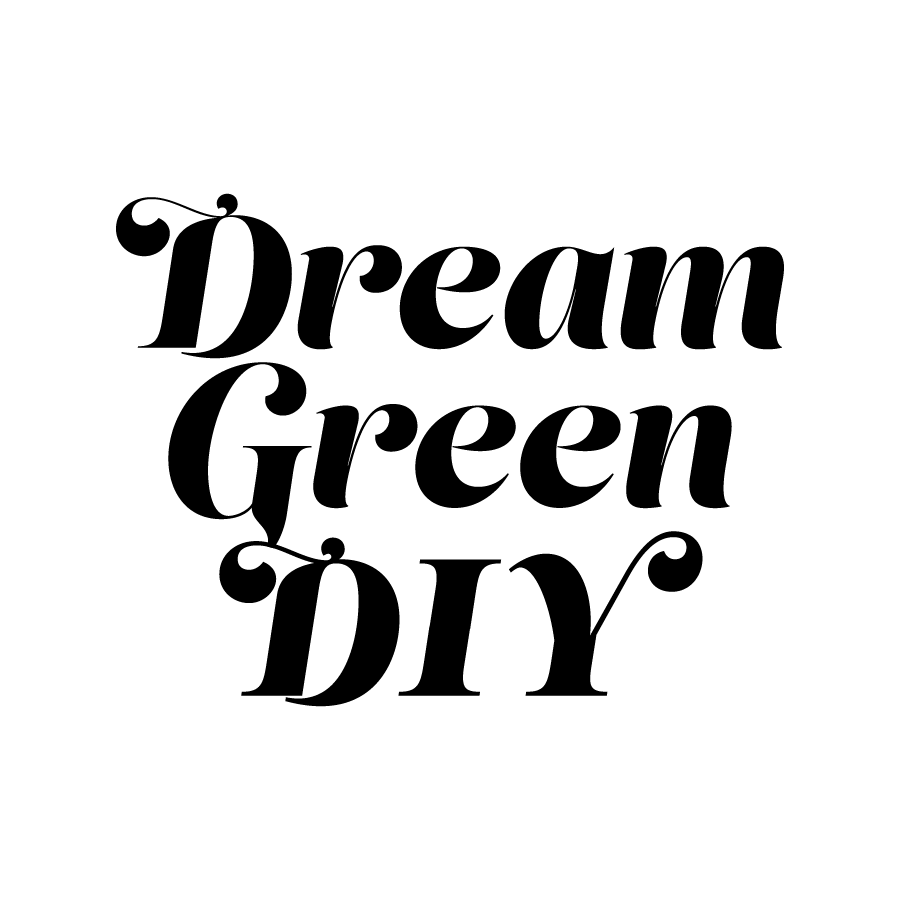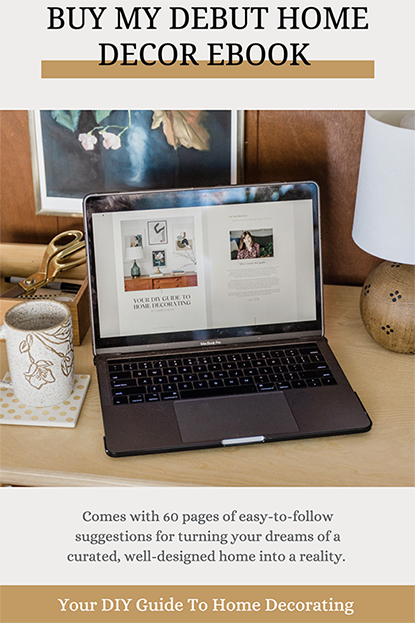.jpg)
Since the moment we first toured our 1960s home two and half years ago, I had visions of adding a hardscape patio to the back yard. There’s an L-shaped section of yard that sits up against our sunroom and kitchen that seemed to practically beg for some kind of porch or deck, and I eventually landed on the idea of a paver patio—a seating and dining area that was flush with the grassy yard, where we could lounge and enjoy breakfast, lunch, and dinner under the shade of our home’s walls and roofline.
Well, fast forward almost three years, and we finally pulled it off! John and I (along with both of our dads) finished installing the patio mid-April, and we’ve been enjoying it every single day since then. You’ve seen sneak peeks of the setup, including this Memorial Day-themed post where I experimented with a sofa setup, but today I’m going to take you through the entire installation process, from start to finish. Grab a tea, coffee, or glass of wine, and keep scrolling to read the full story and see all of the photos.
.jpg)
.jpg)
.jpg)
.jpg)
.jpg)
.jpg)
.jpg)
.jpg)
In case you missed the introduction to this project, click back here. In that post, I explained our main motivation and plans for putting in this hardscape patio, plus walked you through our initial material selection. In the end, we chose this neutral stone paver in the color “Ashland.” We loved the soft beige tones, and the fact that it had built-in decorative grooved lines on top that would ultimately make the patio look like it was made of hundreds of individual tumbled stones. The built-in spacers on the sides of this particular paver also allowed us to speed through the paver installation phase. There was no need for us to use individual plastic spacers to make sure we had even gaps between the pavers because the built-in “bosses” on the paver sides did that for us, and created neat, tidy gaps.
.jpg)
.jpg)
.jpg)
.jpg)
.jpg)
So, with our materials selected and ordered with delivery for the following week, John and I got started prepping the space. The first step was to decide on a size. After mapping it out with yard flags, we settled on a 12-foot-by-16-foot patio. We swapped our flags out for wooden yard stakes, and knotted bright pink string between the stakes to create a more accurate outline of the final patio. Then, John grabbed a shovel, marked the 5-inch depth on it using painter’s tape (we would need to go down five inches to account for both base layers and the final 2-inch-thick pavers), and then started digging out the border. We went about six inches beyond the edges of our final patio boundary because we planned on adding plastic edger pieces there for stability. More on that later.
.jpg)
.jpg)
.jpg)
.jpg)
It took a couple of days for us to dig out the space, and to haul all of the excess earth away. We dumped all of that temporarily in the back of our property, and we’ll either use it for landscaping projects this summer or take it to the yard waste section of our local landfill. If you remember from this post, we had to remove a row of established yew bushes to make way for the patio. Those roots were tough and went deep, so we borrowed a tiller machine from a friend of ours to churn up those harder sections of earth for removal. After that last section was dealt with and the ground was generally even, we took a small break while we waited on delivery of the base materials and pavers.
.jpg)
.jpg)
.jpg)
.jpg)
.jpg)
.jpg)
The first layer in a DIY hardscape patio is the paver base. This is a gritty mix of rock dust and gravel that’s used to cover the raw earth. When that was delivered, we got to work slicing open and dumping the bags all across our excavated patio space. A lawn rake helped distribute the material evenly, and then John went back and forth with a handheld tamper to level and compact the paver base to a relatively smooth finish. He did this three times to achieve a really solid base layer. You can rent a full size tamping machine that makes this process go faster, if you prefer. Note that we had a level string knotted taut between stakes at all corners to help us keep the final shape and depth in mind as we got the paver base in place.
.jpg)
.jpg)
.jpg)
.jpg)
.jpg)
.jpg)
.jpg)
.jpg)
The paver base allows you to get things pretty level, but it’s really this next paver sand step that finalizes the smoothness of your patio base. To get things just right, John and my dad went out and bought two 1-inch thick metal pipes (TIP: make sure you buy pipes that measure 1-inch in diameter from outside edge to outside edge—not 1-inch interior diameter). These were laid roughly 30 inches apart on top of the paver base in the furthest corner of the patio, and then they dumped paver sand out on top of the pipes. Next, they used a straight board as a screed to level out the sand over top of the pipes. It’s the hard pipes that allow you to get the perfect 1-inch depth needed for the sand layer. After the sand was smoothed out over the length of the pipes, those were carefully removed without disturbing the sand around them, and then pavers were gently laid on top. Then, the pipes were shifted over to the next row, and the process repeated across the entire patio.
.jpg)
.jpg)
.jpg)
.jpg)
.jpg)
.jpg)
.jpg)
.jpg) We were lucky that we only had two cuts to make on the pavers for our patio. I will say that those ended up being easier than I thought they’d be, though. To cut the paver stones, we bought a masonry grinding wheel for our angle grinder, marked the two pavers that needed to be cut, and bore through the material on both sides to snap the ends off. Then, we laid them in place over the screed sand, just like we did with the other full size pavers.
We were lucky that we only had two cuts to make on the pavers for our patio. I will say that those ended up being easier than I thought they’d be, though. To cut the paver stones, we bought a masonry grinding wheel for our angle grinder, marked the two pavers that needed to be cut, and bore through the material on both sides to snap the ends off. Then, we laid them in place over the screed sand, just like we did with the other full size pavers.
.jpg)
.jpg)
.jpg)
.jpg)
.jpg)
.jpg)
.jpg)
As for finishing touches, we filled gaps along the edges of the patio using white landscaping gravel and more sand, then hammered spikes through lengths of plastic patio edging laid around the outside exposed borders. After that, we backfilled the area around the patio with fill dirt, laid down a thick layer of grass seed, and topped that with fresh top soil. We watered it twice a day everyday for about three weeks, and the grass is already fully grown at the time I’m writing this. We had considered putting in polymeric sand between the joints, but actually like the grooves as they look now. We may add it later on, and if we do, I’ll be sure to share an update. Now for the moment you’ve all been waiting for—the reveal photos!
.jpg)
.jpg)
.jpg)
.jpg)
.jpg)
.jpg)
.jpg)
.jpg)
.jpg)
.jpg)
.jpg)
.jpg)
.jpg)
.jpg)
.jpg)
.jpg)
Resources: Lanterns (similar), Chaise Lounge Chairs, Lumbar Throw Pillows, Blue Planter Pot, Palm Plant, Outdoor Drum Side Tables, Outdoor Dining Set (similar), Outdoor Seat Cushions, Pavers
You’ll, of course, have to use your imagination since the grass hadn’t filled back in when I took these photos, but I think that fresh brown top soil looks a little like mulch, so we’ll just run with it. I absolutely love how our patio turned out, and am so glad that we went with the more neutral stones as opposed to the red ones I told you we had been considering in this post. The soft beige color of the pavers we ultimately picked allow our new outdoor furniture and potted plants to be the star of the show, which I appreciate.
I set up a small dining area using a vintage white metal set that I bought from a local antique store, and added soft seat cushions to the chairs to make them more comfortable. I really wanted to have a lounge area for sunning since we don’t have plans to go to the beach this year, and this set of two was just right. I added a couple of extra outdoor pillows to those for some coziness, and styled the rest of the space with potted plants to establish a Palm Springs-inspired vibe. You can click back here to see the space styled a little bit differently with a sofa setup and different outdoor pillows. Which look is your favorite? Sofa or dining table?
I hope you found this tutorial helpful! Please don’t hesitate to let me know in the comments if you have any questions about any of the steps in this process or the materials we used. We spent about $1,600 on the project (not including furniture and décor), and consider it a good investment since it’s such a low maintenance and functional addition to our home. Keep an eye on the CrossCountry Mortgage Instagram feed later this season for the release of a full video series that I filmed of our project!
.jpg)
*This post contains affiliate links, which means that I earn a small commission when you purchase products that I recommend at no additional cost to you. This allows me to provide free creative content for you to read, save, and share. Rest assured that I never recommend products we wouldn’t use or don’t already love ourselves.

.png)




Awesome job!!
Thank you so much!
Looks great! I like the dining table and lounge chairs.
So glad you like it! Thanks!
Nicely done. Very hard work for everyone involved.
Are you concerned that weeds might grow between the pavers?
I like the loungers and eating area the best but would like to see a rug in there somewhere.
Sheila
Thanks, Sheila! Weeds will definitely be something we have to maintain over time. I think we’ve decided to put down polymeric sand to help keep them at bay. I’ll be sure to blog the process! And you can see the space with a rug here. For this post, I wanted the pavers to be visible in full for those looking to use the tutorial and see what the base patio looks like.